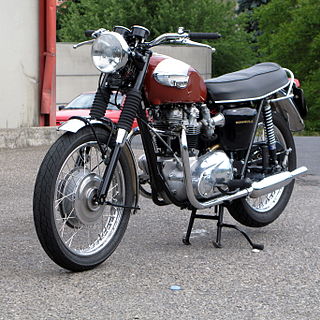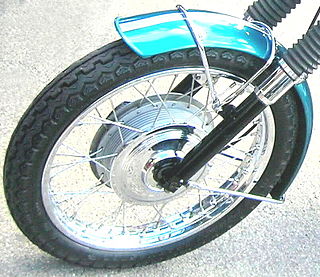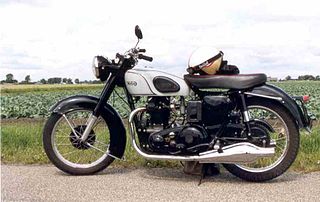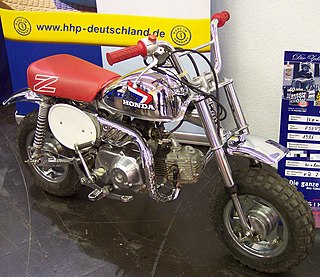
Rat bikes are motorcycles that have fallen apart over time and have been kept on the road and maintained for little or no cost by employing kludge fixes and improvised repairs, with little or no consideration given to appearance. Rat-Look bikes are motorcycles that have been deliberately styled to look like ratbikes. Survival bikes, often confused with rat bikes, may look similar but are different in purpose from rat bikes; they are modified for stylistic reasons to represent a post apocalyptic vehicle.

Vincent Motorcycles was a British manufacturer of motorcycles from 1928 to 1955. The business was established by Philip Vincent who bought an existing manufacturing name HRD, initially renaming it as Vincent HRD, producing his own motorcycles as HRD did previously with engines purchased as complete assemblies from other companies. From 1934, two new engines were developed as single cylinder in 500 cc and v-twin 1,000 cc capacities. Production grew from 1936, with the most-famous models being developed from the original designs after the War period in the late 1940s.

JAWA is a motorcycle and moped manufacturer founded in Prague, Czechoslovakia, in 1929 by František Janeček, who bought the motorcycle division of Wanderer. The name JAWA was established by concatenating the first letters of Janeček and Wanderer. In the past, especially in the 1950s, JAWA was one of the top motorcycle manufacturers and exported its 350 model to over 120 countries. The best known model was the 350 Pérák, and in the 1970s the 350 Californian. It appeared in typical black and red coloring from the US to New Zealand. After 1990 a significant loss of production occurred. A successor company was formed in 1997 in Týnec nad Sázavou, continuing the name as JAWA Moto.
Roadog is a motorcycle built by engineer and motorcycle enthusiast Wild Bill Gelbke between 1962 and 1965. A total of two were built. Gelbke, who had attended engineering school in Wisconsin and at University of Southern California, had worked for McDonnell Douglas and also owned two motorcycle shops in Chicago and Hammond, Indiana. He wanted to create a motorcycle that was dependable and was able to cruise at highway speeds comfortably for long periods. Gelbe constructed and welded the frame himself using 4130 chrome-molybdenum tubing, and equipped the machine with a Chevrolet 153 engine and GM powerglide transmission. The shaft drive was constructed from a Chevrolet 1-ton truck differential that was cut in half. The complete bike is 17 feet (520 cm) long and weighs 3,280 pounds (1,490 kg). Its great size and weight make the bike impossible for most people to steer until it is moving at a speed of at least 15 miles per hour (24 km/h), and when at rest it is held up by hydraulic rams that are deployed by the driver.
American IronHorse was an American motorcycle manufacturer based in the Dallas-Fort Worth, Texas area that was founded in 1995 by Tim Edmondson and Bill Rucker. At one time, AIH was the largest factory producer of custom motorcycles in the USA. Their 224,000-square-foot (20,800 m2) factory was located in Fort Worth, Texas, and housed the complete manufacturing process under a single roof. Although most (305) parts for the bikes were made in-house, such as the seats and wheels, all American IronHorse motorcycles were built with S&S engines and were assembled in-house. By 2006, the company had sold around 10,000 motorcycles. In Spring 2008, American Ironhorse ceased production on all motorcycles and most company assets were liquidated at auction.

The Velocette Thruxton was a sporting motorcycle produced by Velocette between 1965 and 1971. Revealed at the 1964 Earls Court Show, it was the final development of Velocette's antiquated pushrod single, the Venom.

The Triumph Bonneville T120 is a motorcycle originally made by Triumph Engineering from 1959 to 1975. It was the first model of the Bonneville series, which was continued by Triumph Motorcycles Ltd. The T120 was discontinued in favour of the larger 750 cc T140 in the early 1970s.

The Pierce Four was the first four-cylinder motorcycle produced in the United States. The model is included in the AMA Motorcycle Hall of Fame Classic Bikes and Barber Vintage Motorsports Museum. Touting its inline-four engine as "vibrationless", Pierce sold the motorcycle for $325, rising to $400 by 1913, which was expensive at the time, making it popular with "more prosperous sportsmen".

Simplex Manufacturing Corporation was an American manufacturer that made motorcycles from 1935 to 1975. Between 1935 and 1960, Simplex made variations of the Simplex Servi-Cycle including the 1953–1960 Simplex Automatic. Simplex was the only motorcycle manufacturer located in the Deep South for many years, until Confederate Motorcycles began production.

The Dunlop K81 TT100 is a motorcycle tyre thought to be an "obligatory" performance upgrade and a tyre of choice with sporting street motorcyclists during the late 1960s and 1970s due to their shape and relatively sticky compound.

Meguro motorcycles were built by Meguro Manufacturing Co motorcycle works (目黒製作所), founded by Nobuji Murata and a high-ranking naval officer, Takaji Suzuki, in 1937. One of the first Japanese motorcycle companies, it became a partner of Kawasaki Heavy Industries Ltd, and was eventually absorbed. Named after a district of Tokyo, Meguro had its roots in Murato Iron Works, which was established in 1924. Meguro Seisakusho, which had once developed a copy of a Harley-Davidson V-twin, was established to design and build gearboxes for the nascent Japanese motorcycle industry. Abe Industries, which had once produced its own motorcycle, merged with Meguro in 1931. The brand is being revived by Kawasaki with a new K3 model to be introduced in Japan on February 1, 2021.
BikeBandit is a former motorcycle parts superstore retailer founded in 1999 by successful serial entrepreneur Ken Wahlster. Wahlster sold the company in 2013 and has gone on to open other companies in the motorcycle industry as well as other markets. The company was well known for selling motorcycle parts, apparel, and accessories through an online store. The company ceased operations on February 7, 2022.

Robert Frank Currie was an English motorcycling writer and road tester, who later became a magazine editor and book author. Mainly known for his UK journalism work with Motor Cycle, a UK weekly motorcycle magazine-turned-newspaper, then from 1981 as Editor of a new monthly magazine The Classic Motor Cycle, he retired in early 1988 suffering from an ongoing illness, after a full-time writing career starting in 1955, and later died of heart failure.

The Auto Four is a motorcycle designed and built by engineer and motorcycle enthusiast Wild Bill Gelbke during the early 1970s. Approximately seven examples were built. Gelbke, who had attended engineering school in Wisconsin and at University of Southern California, had worked for McDonnell Douglas and also owned two motorcycle shops in Chicago and Hammond, Indiana. After building his Roadog bike during the 1960s, he wanted to create a more practical large motorcycle for touring and police needs that could go into regular production. As with Roadog, Gelbe constructed and welded the frame himself using 4130 chrome-molybdenum tubing. The bikes were equipped with a BMC A-Series engine and General Motors 4-speed automatic transmission. While the frame and body were custom built by Gelbke, electrical parts, such as headlights and taillights, were sourced from General Motors vehicles, for example the taillights from a 1959 Cadillac. Suspension was sourced from Harley Davidson, particularly hydraglide front forks.
William "Wild Bill" Gelbke was an American engineer and motorcycle designer. He is noted for having designed and constructed large motorcycles powered by automobile engines, particularly the Roadog and the Auto Four, the latter a motorcycle intended for mass production. Roadog was intended to be featured on an episode of The History Channel's Modern Marvels, however the bit was cut from the episode.
Cabton is a defunct brand of Japanese motorcycles based in originally in Osaka, Kansai region and later in Inuyama, Aichi Prefecture, that produced motorcycles from 1933 to 1960. The company was started in Osaka by Koushiro Nakagawa and his son. The name is supposed to originate from the slogan "Come and buy to Osaka, Nakagawa".

The Norton Model 7 Dominator was a 500 cc vertical twin motorcycle manufactured by the Norton Motorcycle Company from 1949 to 1955. It was the first of Norton's Dominator range of motorcycles. The engine was designed by Bert Hopwood and was a departure from Norton's previous practice of producing single-cylinder machines. The Model 7 was used in Japan as a police motorcycle.
The Ducati Monza is a 249 cc (15.2 cu in) single cylinder bevel drive SOHC motorcycle produced by the Italian manufacturer Ducati from 1961 to 1968. It was the touring version of Ducati's first 250 cc road bike. Reviews of the Monza praised its speed, road holding, engine smoothness and brakes.

The Honda Z50RD, also known as the Christmas Special or the Chrome Edition, is an all-chrome Honda Z series minibike released in 1986. A limited edition of the Honda Z50R, it is considered to be rare.

The Laverda 750 is a 744 cc (45.4 cu in) air cooled SOHC 4 stroke parallel twin motorcycle produced by the Italian manufacturer Laverda from 1968 to 1976. Developed from the company's 650, the engine's design drew heavily from the Honda CB77. Around 18,000 machines were produced.













